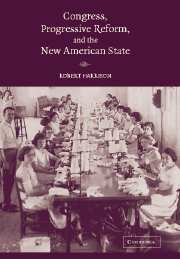Book contents
- Frontmatter
- Contents
- List of Tables
- Preface
- Acknowledgments
- Abbreviations
- Congress, Progressive Reform, and the New American State
- 1 Introduction
- 2 Congress and the Nation
- 3 The Troubled Subject of Railroad Regulation in the Progressive Era
- 4 Congress and the “Labor Question”
- 5 The Ideal of a “Model City”: Congress and the District of Columbia
- 6 The Senate and Progressive Reform
- 7 Patterns of Republican Insurgency in the House of Representatives
- 8 Progressivism, Democratic Style
- 9 Congress, Progressive Reform, and the New American State
- Appendix: The Analysis of Roll Calls
- Index
4 - Congress and the “Labor Question”
Published online by Cambridge University Press: 25 July 2009
- Frontmatter
- Contents
- List of Tables
- Preface
- Acknowledgments
- Abbreviations
- Congress, Progressive Reform, and the New American State
- 1 Introduction
- 2 Congress and the Nation
- 3 The Troubled Subject of Railroad Regulation in the Progressive Era
- 4 Congress and the “Labor Question”
- 5 The Ideal of a “Model City”: Congress and the District of Columbia
- 6 The Senate and Progressive Reform
- 7 Patterns of Republican Insurgency in the House of Representatives
- 8 Progressivism, Democratic Style
- 9 Congress, Progressive Reform, and the New American State
- Appendix: The Analysis of Roll Calls
- Index
Summary
Prologue
On 21 March 1906 in the Speaker's Room of the House of Representatives an encounter took place that held profound significance for the place of organized labor in American politics. A delegation from the American Federation of Labor (AFL), led by its president Samuel Gompers, laid before Speaker Cannon an elaborate “Bill of Grievances” setting out the Federation's legislative demands and protesting at their neglect by Congress. Cannon received these proposals with unconcealed disdain, responding angrily to the allegation that he had discriminated against organized labor in his committee appointments. In his own eyes he had been perfectly faithful to the promise, given to Gompers on his accession to the Chair, that labor would receive a just hearing and that the laws enacted by Congress would favor no one class. But Gompers's organization seemed to demand special privileges: a Labor Committee packed in the interest of organized labor and the passage of “class legislation” for its benefit alone. It did not even represent all industrial workers: “Organized labor is not the whole shooting match. There are the workmen to be considered who refuse to wear the shackles of unionism.” For such men Cannon and the Republican party, with its longstanding commitment to the protection of American labor and the promotion of American industry, claimed to speak with as much authority as the president of the AFL.
- Type
- Chapter
- Information
- Congress, Progressive Reform, and the New American State , pp. 97 - 124Publisher: Cambridge University PressPrint publication year: 2004



